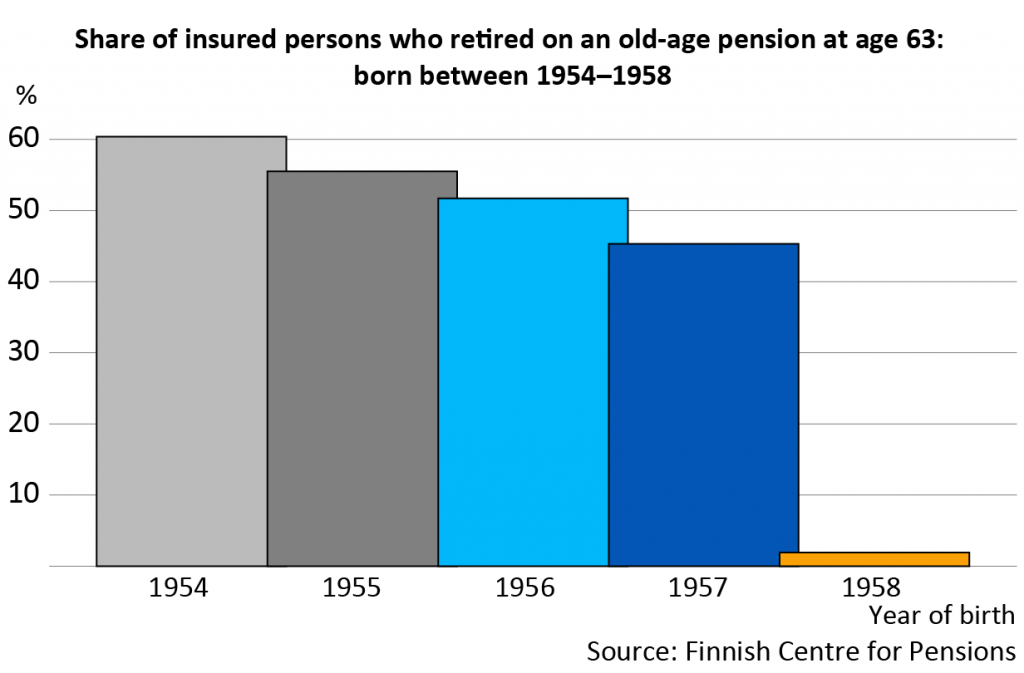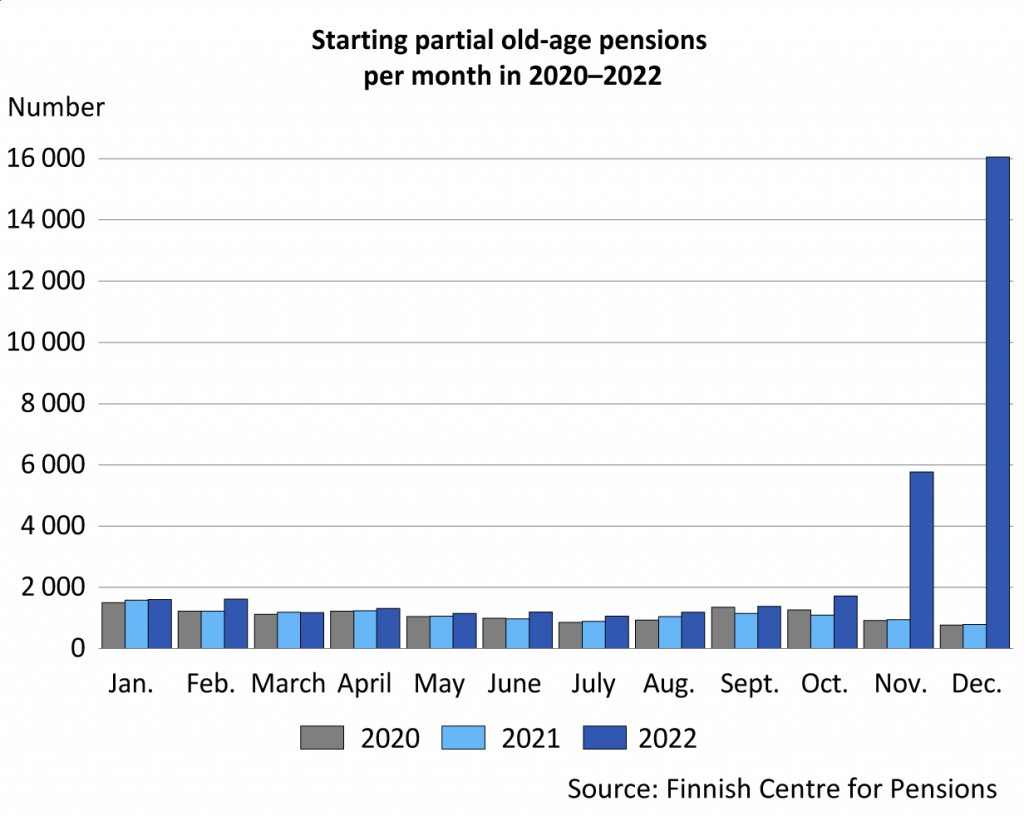New Pension Benefits and the Pension Reform
The website New pension benefits and the pension reform shows how the 2017 pension reform affects the statistics . The pension reform introduced two new pension benefits: the partial old-age pension and the years-of-service pension. The reform also raises the retirement age gradually.
Few retire at age 63

Raising the retirement age has deferred retirement. Those born in 1954 were the last birth cohort with a retirement age of 63 years. 60 per cent of them retired on an old-age pension at age 63, that is, within one year from reaching their retirement age. After that, the share of persons retiring at age 63 of all persons insured for an earnings-related pension decreased by around five percentage points per birth cohort.
Of the insured persons born in 1958, only slightly more than 1,000 (a few per cent) retired on an old-age pension at age 63 since only a few special groups of that birth cohort had the right to retire before the cohort’s retirement age of 64. As soon as the people of this birth cohort reached their retirement age in 2022, more than 20,000 of them retired on an old-age pension. This was about the same number of people as for the previous birth cohorts when they reached their retirement age.
Despite the rising retirement age, most workers have continued working up to their new retirement age. This means that people work longer. At the same time, retirement on a disability pension among those who are close to their retirement age has increased. In 2022, slightly less than 5,000 persons aged 61–63 retired on a disability pension. The number has nearly doubled compared to the time before the 2017 pension reform.
(Updated on 14 November 2023)
Read more:
Flood of pension claims at year-end 2022 raised number of new old-age pensions to a record-high level

In 2022, nearly 35,000 persons took out a partial old-age pension for the first time. The number rose 2.5-fold compared to previous years as a record-high number of pension claims were submitted in the autumn of 2022. In the last two months of the year, the volume of starting pensions nearly doubled compared to earlier in the year.
The main reason for the steep rise in pension claims at the end of the year was the exceptional index development which encouraged people to retire towards the end of the year. This way, the considerable index increase to earnings-related pensions in payment at the beginning of 2023 was ensured.
Over several years, almost every tenth person aged 61 or more has selected to draw the partial old-age pension soon after reaching the eligibility age. Last year, exceptionally many – nearly 12,000 persons – of those born in 1961 chose to draw the pension. At the same time, the share of persons of that birth year who were eligible for the pension rose to 17 per cent, that is, doubled compared to previous years.
On average, the youngest age group took out their partial old-age pension 42 months early. This meant that the part taken early was reduced by 16.8 per cent. In euros, the average reduction on a 50-per-cent partial old-age pension amounted to 150 euros/month. The average paid out monthly pension amounted to 750 euros.
At year-end 2022, a total of 52,000 partial old-age pensions were in payment. The amount rose by 20,000 in one year. Men accounted for 58 per cent of the partial old-age pension recipients. More than 42,000 persons taking out a partial old-age pension took out 50 per cent of their accrued pension. This means they received an average monthly pension of 830 euros per month (or a median pension of €740/month).
(Updated on 3 May 2023)
Additional information:
Years-of-service pension paid to 104 persons at year-end 2022
The years-of-service pension was introduced in connection with the 2017 pension reform. The pension can be granted to individuals who were born in 1955 or after and who have done work that requires great mental or physical effort for at least 38 years. The first years-of-service pensions were paid out in the spring of 2018. The years-of-service pension can be paid out between age 63 and the retirement age for an old-age pension, so the partial old-age pensions that began last year have been in payment for a maximum of one year and three months.
Years-of-service pension 2018–2022
| 2018 | 2019 | 2020 | 2021 | 2022 | |
|---|---|---|---|---|---|
| Claimants | 101 | 111 | 208 | 266 | 352 |
| Starting pensions | 21 | 27 | 72 | 84 | 119 |
| – Average pension €/month | 1,870 | 2,081 | 2,173 | 2,074 | 2,115 |
| Pensioners at 31 Dec. | 5 | 15 | 62 | 75 | 104 |
(Updated on 3 May 2023)
Additional information:
Statistical services provides further information: